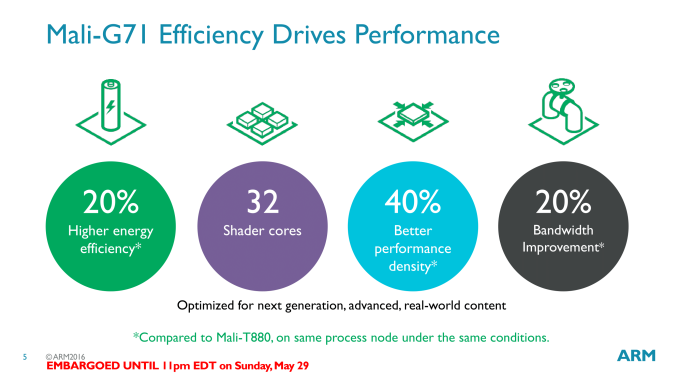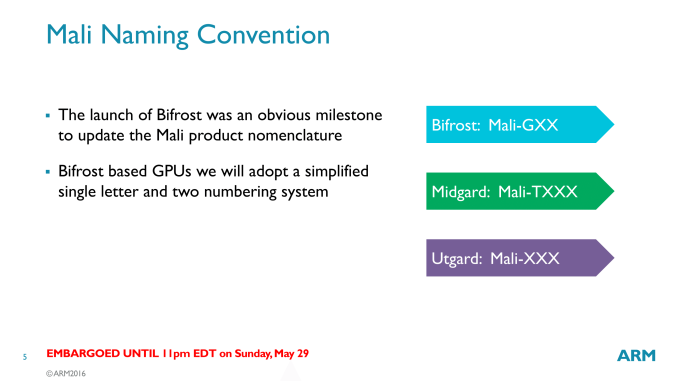ARM Unveils Next Generation Bifrost GPU Architecture & Mali-G71: The New High-End Mali
by Ryan Smith on May 30, 2016 7:00 AM ESTWrapping Things Up: Mali-G71, Coming Soon
Like ARM’s associated Cortex-A73 announcement, today’s Mali-G71 revelations are being made ahead of actual silicon availability. To that end a lot of ARM’s projections are based on early prototyping of manufacturing process and architectural simulations, though at this late stage those simulations tend to be pretty close.
ARM’s official numbers for G71 call for it to offer significant improvements over a same-process Mali-T880 with respect to both energy efficiency and density. For the former ARM is expecting G71 to deliver 20% better energy efficiency over T880, and on the latter to offer 40% better performance density – or in other words, the same performance at 40% less die space. Though ARM has not been heavily penalized for area efficiency, the latter has been one of the few areas where they haven’t done quite as well, and is something competitor Qualcomm is keen to call them out on.
From a performance standpoint, ARM is expecting G71-based devices to offer around 1.5x the performance of current, T880 devices. This is a slightly fuzzier metric – it’s not 50% faster at the same MP configuration – but rather a combination of manufacturing improvements, a larger number of shader cores, and Bifrost architectural improvements. Andrei also suspects that if we were looking at apples-to-apples ISO-power/ISO-area numbers where everything was held equal, the actual performance gains would be even greater.
With all of that said, expect to see G71 operate a lot like a drop-in replacement for current Mali GPUs when it comes to graphics. Bifrost is an architectural update for Mali rather than a feature update. There are no major graphics features that G71 supports that T880 does not; both deliver on the same OpenGL ES and Vulkan graphics functionality. The heterogeneous compute functionality on the other hand stands to make a big impact for general compute tasks, just not for graphics.
Ultimately what this gets ARM is a chance to recalibrate their architecture for the future, to better align with both what software developers are writing and what device manufacturers need in their GPUs. Bifrost is the new modern Mali, and the shift to a TLP-centric design should serve ARM well in the future based on what we’ve seen similar shifts do for AMD and others. Meanwhile the overall performance gains will allow ARM and its customers to hedge their bets on things such as 4K phones and mobile VR, giving them a more suitable GPU design to use if those innovations prove popular.
Wrapping things up, while ARM is only announcing the Mali-G71 today, the company has clearly left the door open to future GPU designs. As a high-end GPU design, G71 is the immediate successor to the T880, but I expect in time that ARM will want to produce GPU designs suitable to replace Mali T820 and the like. That ARM started at G71 is a good hint of what’s to come; future Bifrost GPUs will use the two digit G numbering scheme, so you can easily see where future GPUs may slot in.













57 Comments
View All Comments
Ranger1065 - Monday, May 30, 2016 - link
Interesting but not quite the GPU review the faithfull are awaiting...hope springs eternal.Shadow7037932 - Monday, May 30, 2016 - link
This is more interesting than a GTX 1070/1080 review imo. We more or less know what the nVidia cards are capable of. This ARM GPU design will be relevant for the next 2-3 years.Alexey291 - Monday, May 30, 2016 - link
Well yeah, ofc it's not interesting anymore because by the time their reviews hit whatever it is they are reviewing is a known quantity. 1080 in this case is a perfect example.name99 - Tuesday, May 31, 2016 - link
Oh give it a rest! Your whining about the 1080 is growing tiresome.SpartanJet - Monday, May 30, 2016 - link
Relevant for what? Phone GPU's are fine as is. For mobile gaming? Its all cash shop garbage. For productivity? ADroid and iOS pale in comparison to a real OS like Windows 10.I find the Nvidia much more interesting.
name99 - Tuesday, May 31, 2016 - link
"Phone GPUs are fine as is."And there, ladies and gentlemen, is the "640K is enough for anyone" of our times...
Truly strong the vision is, in this one.
imaheadcase - Tuesday, May 31, 2016 - link
He is not wrong though. A faster GPU on one offers nothing for people as of right now. If you look at the mobile apps that are used, not a single one would even come close to using what they use now..and phones are at max quality for the screen size they use.The only way phones can improve now that users would notice is storage/CPU/and better app quality in general which is terrible.
shadarlo - Tuesday, May 31, 2016 - link
You realize that GPU's are used for things beyond prettying up a screen right?Lets just stop advancing mobile GPU's because in the future we will never use anything more advanced that needs more power or less power usage... *eye roll*
ribzy - Monday, November 21, 2016 - link
I think what he's trying to say is that the content is not available or sufficient right now to really justify the cost. Let's say you built a car but don't have the fuel that's needed to power it. Or what about those that got a 4K TV early and now are stuck with something that doesn't have HDR and that runs old, not updateable TV software. I understand his concern.mr_tawan - Thursday, June 2, 2016 - link
Well as the phone's and tablet's resolution is going ridiculously higher and higher everyday, having strong GPU is a must. It's not all about gaming, it affects day-to-day use as well. Everything on displays now on every OS nowadays are hardware-accelerated. And the current mobile GPU are under-power comparing to the task it's given (eg. driving 2K displays at 60fps).